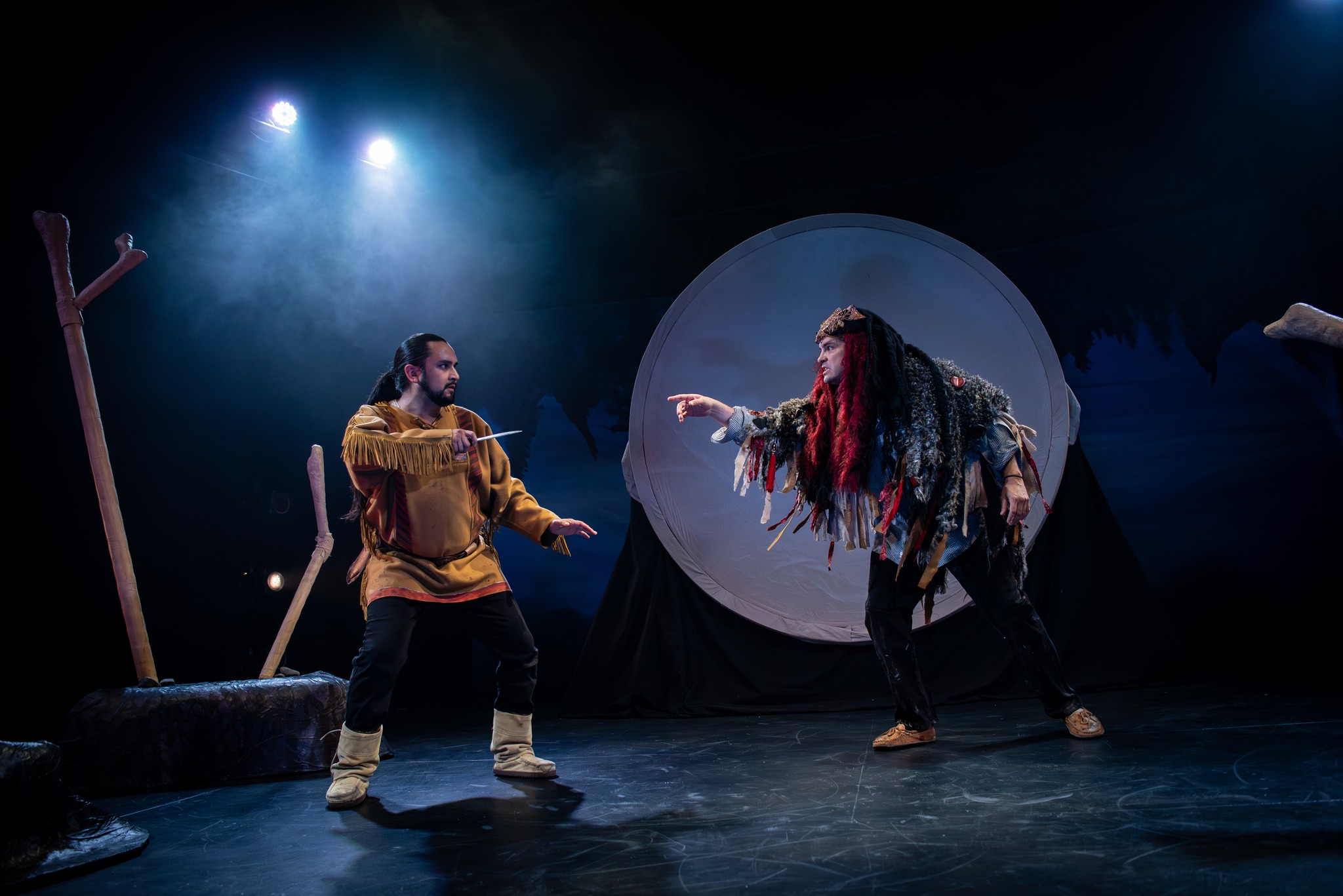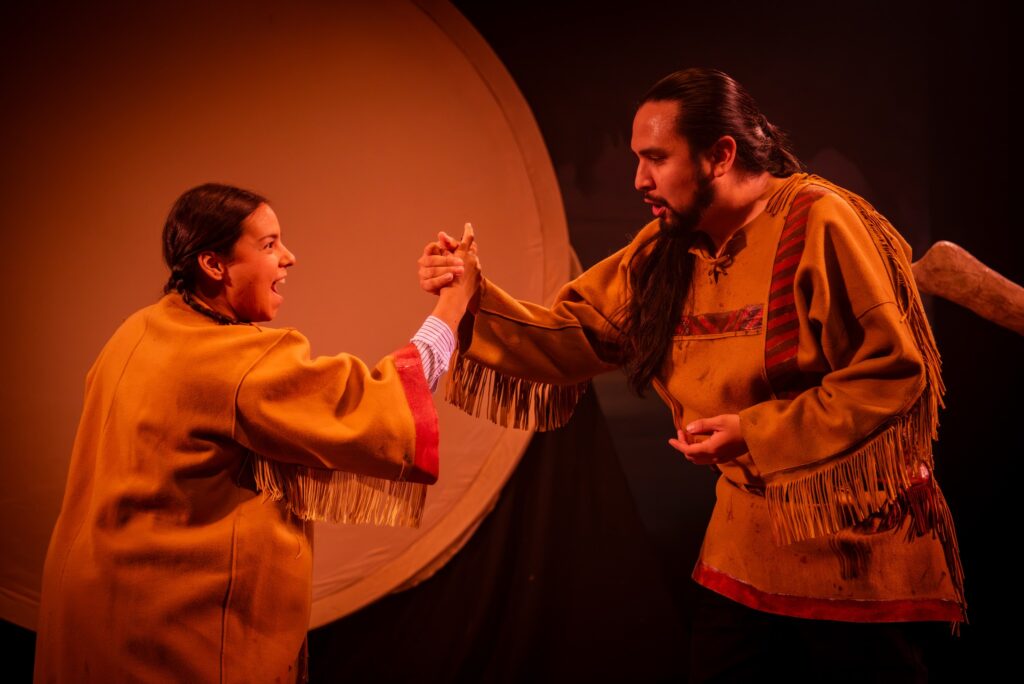
Photo by Stoo Metz
Akpik Theatre’s production of Pawâkan Macbeth, which had a sold-out run at Neptune Theatre’s Scotiabank Studio Theatre during the Prismatic Arts Festival, is a powerful and moving reimagining of Shakespeare’s Scottish play, set in Plains Cree territory in the 1870s, and exploring the ways in which otherwise moral and honourable people can be led to commit the foulest of deeds against one another.
The story centres on Macikosisân, played with great nuance by 𝗰̌𝗮𝗰̌𝘂𝗺𝗵̣𝗶 (Aaron Wells), who hears a prophecy from the coyote howlers, called wiyoyowak, that he will become Chief, although initially he does not fully believe these creatures to be trustworthy. However, the idea of becoming Chief ignites his ambitious spirit, and soon, with the help of his wife Kâwanihot Iskwew, in a powerful and deeply layered performance from Lisa Nasson, they start devising a plan to make this prophecy come true, by any means necessary and at any cost.
The backdrop of the story is actually darker than the narrative itself. In the 1870s in this place the Indigenous peoples’ land and nations were being steadily attacked and colonized across all that is known as Canada today, from East to West. At this time the Western treaties had not been signed, but the newly named Canadians, who had recently reached an agreement for the Confederation of seven provinces and one territory, had their sights set on amassing all the rest of the land for their new country. At the same time the Cree and Nakoda were in the midst of a century-long war against the Blackfoot. The Colonization of the seven provinces and one territory had caused widespread famines, outbreaks of disease, and of course, just a general upheaval and traumatic anxiety among all the Indigenous peoples across Turtle Island, and this turmoil provides the context out of which Macikosisân becomes consumed by the Cannibal Spirit (Wihtiko).

The Chief, Okimâw Wîpâstim, played by JD Montgrand, recognizes that the settlers pose a much larger threat than the various conflicts between different Nations and suggests that they stop fighting with one another, and find a common ground to work together to resist the encroaching Canadians. Okimâw Wîpâstim is also a very likeable character, making Dad jokes, and showing care and compassion, not just for his own son (played by Spencer Streichert), but for everyone he encounters. Macikosisân convinces himself that the Chief’s compassion is a weakness, and uses that in part as justification for murdering him and insinuating that the murder was committed by his son, who flees in horror and terror.
Macikosisân is pushed toward the murder by his cold and calculating wife, who is visibly pregnant, and so in this telling of the story we see that while Kâwanihot Iskwew can seem heartless, in fact, she is desperate to try and give her future child a better future than the one that she and Macikosisân had when they were born. Playwright Reneltta Arluk gives us rich backstories for Macikosisân, Kâwanihot Iskwew, and also for Maskwa, Macikosisân’s friend who later becomes his greatest adversary. They have all lost their mothers and inherited the trauma from centuries’-worth of violence, disease, invasion of their land, and loss of their traditional ways. The characters often speak about how their current choices and behaviour may not be their ways, but how they are both being forced to make sacrifices and change their ways in order to survive, and also are being introduced to ways that are, at a human level, tempting, which is how Macikosisân and Kâwanihot Iskwew get lured into leaning into greed and selfishness, despite the fact that it unroots them from the traditional teachings of their culture. In this way Macikosisân and Kâwanihot Iskwew are easier for audiences to empathize with than, perhaps, their Shakespearean counterparts.
The play is a mixture of text written in both English and Cree by Arluk, and also lines written by William Shakespeare, and it is to Arluk’s credit that there were times when I could not tell how much of the text was directly from Shakespeare, and how much had been reimagined in his style. It is a beautifully constructed play. As someone who doesn’t understand Cree, I never felt that I was missing out on anything, or that I was confused. I also don’t think one needs to be familiar with Shakespeare’s Macbeth to have an enriched experience; Pawâkan Macbeth works perfectly on its own. While it deals with very dark subject matter, there is also a lot of levity in the play, mostly in the way that the three wiyoyowak mirror Shakespeare’s three witches. At times the wiyoyowak are almost a silly parody of Shakespeare, which is apt because Shakespeare’s vision of the witches was a kind of caricature too of his (mis)understanding of Celtic culture and traditions. Mitch Saddleback also has an especially hilarious direct address monologue to the audience, which works well in the Shakespearean style, that helps us to connect the play to the ongoing history of what is now Canada, leading up to today.

There are just six actors who bring this story to such vivid life, many actors play multiple characters, and all six work beautifully together to give a sense of the world being so much larger than just six individuals. Mallory Amirault gives a harrowing monologue that describes the birth of Maskwa, famously “not of woman born,” which also brings the audience more into Maskwa’s generational experience. The birth is not just a twist ending, it is something that has informed who this person has grown up to be, and it hasn’t just affected him, the death of his mother has had reverberations for his entire family, and community as well.
The direction by Reneltta Arluk and the costumes by Logan Martin-Arcand, and the set design by Cimmeron Meyer, and lighting design by Brad Trenaman all come together so beautifully, using light and shadow, deep blues, and the raggedy costumes of the wiyoyowak, to give the play a very ominous and wretched, and also shadowy and mysterious ambiance. It is not the literal end of the world, but it is an apocalypse of sorts for these communities, who are very literally staring at the end of their lives, their lands, and their communities as they know them.
I was struck for the first time in my life when I first read the synopsis for this play that William Shakespeare borrowed this story from, what I had assumed was Scottish lore. Shakespeare wrote The Tragedie of Macbeth around 1606. Scotland’s history is complex, and I am just starting to learn more about it, but around the same time King James (VI of Scotland, but importantly, the First of England) was beginning to try to colonize the Gàidhlig-speaking “rogue Highlands” more and more in a markedly British way. This led directly to the mass emigration of Highland Scots to what is now known as Nova Scotia, Prince Edward Island, and other parts of Mi’kma’ki by the late 1700s. Shakespeare, who was, of course, British, took an old story about real Highlanders who once lived in Medieval times, but not at all based on fact, and appropriated it for consumption by his British audiences, and to curry favour with his Lowland Scottish King. Colonization is, therefore, baked into this story already, and I wonder how Na Gàidheil (The Gaels) in 1606 would have felt if they had seen The Tragedie of Macbeth. Would they have felt flattered that the Bard was interested in their culture? Would they have laughed at how inaccurate it all was? Would they have felt like a piece of their history and their culture was being stolen from them? Or would they have felt offended that Shakespeare was playing into stereotypes of the bloodthirsty barbaric heathen Highlander? In rooting the story in her own culture Reneltta Arluk has given this story a truth that the original lacks, which is perhaps one of the reasons that Pawâkan Macbeth feels so much more powerful, sad, and also, ultimately, triumphant.
Pawâkan Macbeth at Neptune Theatre has closed. Please visit Akpik Theatre‘s website for more information about future productions.




 World Theatre Day: My God Is It Ever The Time to Invest in Canadian Plays
World Theatre Day: My God Is It Ever The Time to Invest in Canadian Plays 
